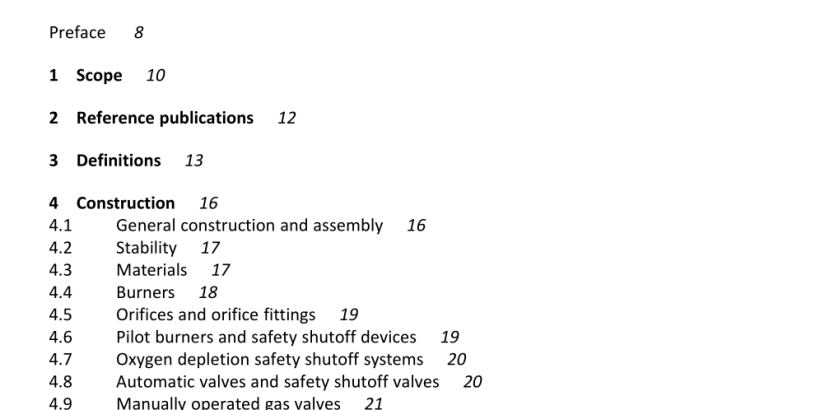CSA ANSI Z21.103-2017 pdf download.Unvented portable type gas camp heaters for indoor and outdoor use
3 Definitions
The following definitions shall apply in this Standard: Accessory — a compatible component supplied by the appliance manufacturer that will still allow safe operation of a unit, which is not necessarily provided with the appliance at the time of purchase. Angle of critical balance — the minimum angle through which a heater must be tipped to cause the heater to tip over due to solely the force of gravity. Automatic valve for gas appliances — an automatic or semi-automatic device consisting essentially of a valve and operator that controls the gas supply to the burner(s) during normal operation of an appliance. The operator may be actuated by application of gas pressure on a flexible diaphragm, by electrical means, by mechanical means, or by other means. Semi-automatic valve — a valve that is opened manually and closed automatically, or vice versa. BTU — abbreviation for British Thermal Unit. The quantity of heat required to raise the temperature of 1 pound of water 1°F. Burner — a device for the final conveyance of the gas, or a mixture of gas and air, to the combustion zone. Catalyst — a material used to promote a reaction between fuel gas and oxygen during the combustion process of a fuel gas, but which, itself, does not enter into the combustion process. Catalytic heater — an open face, unvented heating appliance that utilizes a catalyst in the combustion process of a fuel gas. Catalytic pad — a porous structure containing a catalyst through which a fuel gas passes.
Combustion — as used in this Standard, the rapid oxidation of fuel gases accompanied by the production of heat or heat and light. Combustion products — constituents resulting from the combustion of a fuel gas with the oxygen of the air, including the inerts by excluding excess air. Controls — devices designed to regulate the gas, air, water, or electrical supplies to a gas appliance, which may be manual, semi-automatic, or automatic. Cubic foot of gas — the amount of gas that would occupy 1 ft 3 at a temperature of 60°F, if saturated with water vapor and under a pressure equivalent to that of 30 inches of mercury. Cylinder, fuel — as used in this Standard, a container complying with the Department of Transportation specifications for containers used for the transportation and storage of liquid and/or vapor fuels. Discharge air openings — an opening or a series of openings in the same plane separated by less than 1 inch of unbroken surface between openings through which heated air (excluding flue products) is discharged. For any opening through which ambient air is drawn in and discharged at a higher temperature through the same opening, the entire opening is to be deemed the discharge air opening.
Excess air — air that passes through the combustion chamber and the appliance flues in excess of that which is theoretically required for complete combustion. Extinguishment — for the purpose of the combustion test specified in Clause 5.4, Combustion, extinguishment is considered to be reached when combustion of the gas supplied to the heater ceases to occur at the burner ports, within the burner body, within the burner venturi, and on the face of the burner orifice. Flue gases — products of combustion and excess air. Heating value (total) — the number of British Thermal Units produced by the combustion at constant pressure of 1 cubic foot of gas, when the products of combustion are cooled to the initial temperature of the gas and air, when the water vapor formed during combustion is condensed, and when all the necessary corrections have been applied. Hydrocarbon — those compounds composed of carbon and hydrogen that form the primary constituents of various fuel gases. Hydrocarbon, unreacted (unburned fuel gas) — that portion of the hydrocarbon fuel gases passing through a catalytic pad that do not react with oxygen during the combustion process.CSA ANSI Z21.103-2017 pdf download
